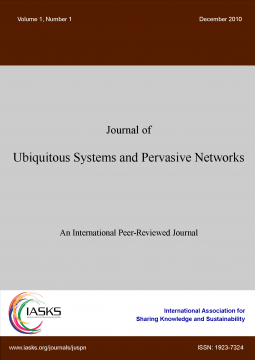volume-11-Issue 2 (2019)
Latest Articles
The Multi-Agent System Solutions for Big Multi-sensor Data Management
JUSPN, volume-11, Issue 2 (2019) , PP 23 - 29
Published: 19 Dec 2019
DOI: 10.5383/JUSPN.11.02.004
by Zakarya Elaggoune, Ramdane Maamri and Imane Boussebough from Lire Laboratory, University of Constantine 2 – Abdelhamid Mehri Constantine, Algeria, 25000
Abstract: This research realizes the multi-agent community to handle the rinsing challenges in smart cities by the combined use of multi-fuzzy-agent systems for extracting relevant data from big noisy data, and the multi-agent systems-of-systems for adaptive big data processing. A multi-agent-based large wireless sensor network is used to show the approach used by the multi-fuzzy-agent systems, it exploits sensors as autonomous fuzzy agents that measure the relevance of the collected data and eliminate irrelevant ones. The aim of the multi-agent systems-of-systems is to handle the super velocity of big data flood in an adaptive way, which break down the rigidity of current big data systems that are forced to restart the data analysis process periodically to integrate the newly generated data into the analytical cycle. read more... read less...
Keywords: Big data, Multi-agent system, Wireless sensor network, Fuzzy logic, System of systems, Relevant data
Optimizing Web Service Composition with Graphplan and Fuzzy Control
JUSPN, volume-11, Issue 2 (2019) , PP 15 - 21
Published: 16 Dec 2019
DOI: 10.5383/JUSPN.11.02.003
by Guodong Fan, Ming Zhu, Xiaoliu Cui from College of Computer Science and Technology, Shandong University of Technology, Zibo, China
Abstract: With the development of cloud computing, more and more applications are posted online to provide services for users. Since user needs can be complex, an individual service will not able to meet the requirement. Web Service Composition composes multiple web services together to fulfil the complicated user requirement. While searching an optimal composition with both functional and non-functional requirements still is a challenging problem that needs to be addressed. QoS-aware web service composition is an NP-hard problem. To solve this problem, we design a system which combines GraphPlan with Fuzzy Control algorithm. Fuzzy Control is employed to generate overall QoS according to user preferences. In the forward phase of Graphplan, less competitive services are pruned according to the overall QoS. In the backward phase, services are selected according to functional goals and their overall QoS. Furthermore, case study and are performed, and the experimental results show that our approach improves the quality of service composition significantly compared with ordinary and Skyline approach. read more... read less...
Keywords: fuzzy control, cloud computing, GraphPlan, QoS-aware service composition
Green Service Level Agreement Compliance for Optical WDM Networks
JUSPN, volume-11, Issue 2 (2019) , PP 09 - 14
Published: 12 Dec 2019
DOI: 10.5383/JUSPN.11.02.002
by Yashar Fazilia, Bill Robertson, William Phillips from Dalhousie University, Halifax, NS, Canada, B3H 4R2
Abstract: In this paper we consider Green Service Level Agreement (SLA) as a constraint in finding a route for a dynamically received connection request in Wavelength Division Multiplexing (WDM) networks. We show that it is possible to save energy and reduce Greenhouse Gas (GHG) emission while satisfying optical network SLAs. The Integer Linear Programming (ILP) method introduced in this paper has been engineered to be simple and be solved in a timely manner needed for serving a dynamic connection request in control plane of the optical network. The ILP method introduced in this paper for the control plane of Optical WDM networks could also be used for the control plane of Software Defined Networks (SDN) and Software Defined Wide Area Networks. read more... read less...
Keywords: GMPLS, Green Networks, Control Plane,
An inexpensive wireless smart camera system for IoT applications based on an ARM Cortex-M7 microcontroller
JUSPN, volume-11, Issue 2 (2019) , PP 01 - 08
Published: 05 Dec 2019
DOI: 10.5383/JUSPN.11.02.001
by M. Tresanchez, A. Pujol, T. Pallejà, D. Martínez, E. Clotet, J. Palacín from Department of Computer Science and Industrial Engineering, University of Lleida, Lleida, Spain, 250
Abstract: This paper presents a new proposal of a low-cost and low-power wireless smart camera device, designed to be used as an inexpensive smart image acquisition edge node for Internet of Things (IoT). Taking the advantages of the ARM CortexM7 microcontrollers, a high-performance STM32F7 microcontroller is used as a main digital signal processor (DSP) to acquire and transfer images at full rate, keeping the core idle to do real-time image processing. In order to design a very compact, low-cost and low-power wireless image sensor node, the DSP is supported by an embedded 1.3 Mega Pixel CMOS camera sensor and a low consumption 2.4GHz Wi-Fi module. This setup allows a custom build-in image processing algorithm for specific IoT sensing applications or a simply setup as low-cost streaming Motion JPEG (MJPEG) wireless camera node. In this work, both configurations have been tested and analyzed. Results show that the device can acquire and process images simultaneously at a full rate (30 fps) and the MJPEG transmission reaches 7.23 fps with a QVGA resolution. read more... read less...
Keywords: IoT node, Image sensor, Video streaming, ARM, Cortex-M7

